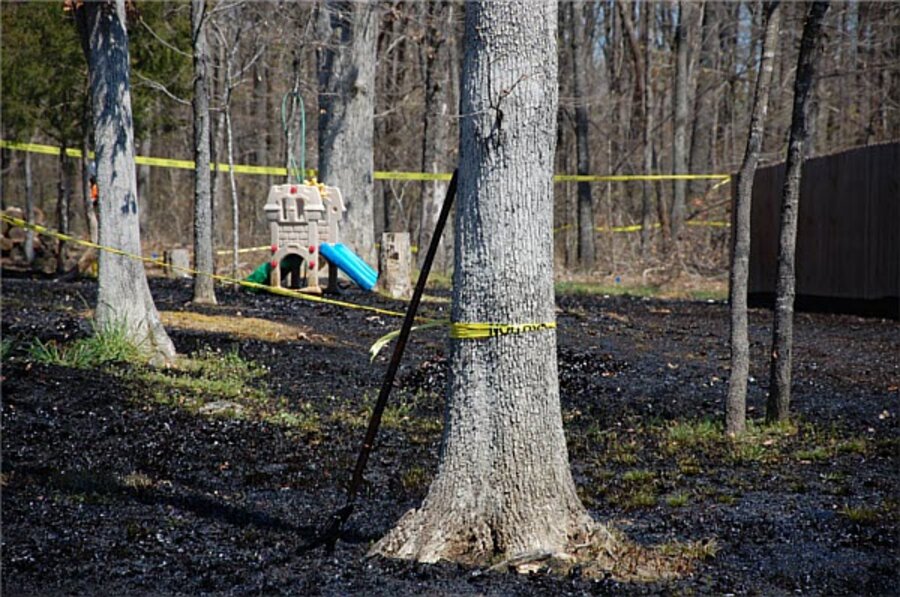For Keystone XL foes, oozing Canadian crude in Arkansas spill is black gold
Loading...
The rupture of an ExxonMobil pipeline that sent a gooey black stream of heavy Canadian crude oozing across lawns and driveways in suburban Mayflower, Ark., last Friday has been seized upon by opponents of the Keystone XL pipeline as proof that the controversial project should be halted.
The break in the more-than-60-year-old Pegasus pipeline, environmentalists and homeowners say, illustrates the inability of oil pipeline companies to prevent spills that can wreak havoc on local environments, including important water aquifers along the 1,700 mile Keystone XL’s projected route. An Obama administration ruling on the pipeline is expected sometime this summer.
“The oil companies have made it clear that their priority is not safety, it’s profit margins,” Glen Hooks, a spokesman for Arkansas Sierra Club, said in a statement. “Why should we trust oil companies when they say their pipelines are safe when there have been spill after spill?”
In the spill Friday, thousands of barrels of oil flowed through Starlite Road and Shade Tree Lane and forced the evacuation of 22 homes in Mayflower, about 20 miles northeast of Little Rock.
More than 300 cleanup personnel from the pipeline company’s parent, ExxonMobil Corporation, were on the scene using vacuum trucks to collect the oil, authorities said Tuesday. Local responders erected dirt and rock dams to block culverts from dumping crude into nearby Lake Conway, a fishing lake. Several oil-covered ducks were found, including two that died.
State Attorney General Dustin McDaniel announced Tuesday that Arkansas was launching an investigation into the pipeline release and warned ExxonMobil to retain all documents and relevant data.
"There are many questions and concerns remaining as to the long-term impacts, environmental and otherwise, from this spill," he said in a statement.
As of Sunday, cleanup crews had collected some 12,000 barrels of oil and water, according to the Mayflower Incident Unified Command, which is overseen by the Environmental Protection Agency and US Department of Transportation's Pipeline and Hazardous Materials Safety Administration (PHMSA).
The spill, categorized as “major” by the EPA, is a double whammy for ExxonMobil, coming less than a week after PHMSA proposed a $1.7 million fine for a July 2011 crude oil pipeline failure in the Yellowstone River near Laurel, Mont. The government alleges that ExxonMobil failed to properly address known seasonal flooding risks to the safety of its pipeline system, including excessive river scour and erosion, or take steps that would have mitigated the spill.
The Pegasus pipeline that burst Friday is an 858-mile, 20-inch-diameter crude oil pipeline owned and operated by a subsidiary of ExxonMobil Corporation of Irving, Texas. Federal ownership records show that PHMSA also sought to fine ExxonMobil Pipeline company $26,200 in 2010 for failing to properly inspect the Pegasus where it crossed the Mississippi River between Missouri and Illinois.
Occurring just weeks ahead of April 18 discussions between the US State Department and Nebraska authorities, the Pegasus spill is being hailed as an object lesson by pipeline opponents and as an unfortunate incident with little broader meaning by Keystone proponents.
“We regret that this incident has occurred and apologize for any disruption and inconvenience that it has caused,” said Karen Tyrone, southern operations manager of ExxonMobil Pipeline Company. “Our focus is on protecting health, safety, and the environment. We will be here until the cleanup is complete.”
But environmentalists say the recent spill is indicative of a larger problem with pipelines and that, if built, the Keystone XL will be a big spill waiting to happen.
TransCanada, the company that wants to build the pipeline from Alberta’s tar sands across America’s heartland to Gulf Coast refineries, says construction of the Keystone XL would create tens of thousands of jobs in the US and fill state coffers with billions in property tax revenues. Critics say there would be very few long-term jobs.
While proponents of the pipeline say it would enhance US energy security, detractors say the pipeline would pose a threat to the vital Ogallala Aquifer that is a major source of drinking and crop irrigation water, and that the process of harvesting the crude from the tar sands is a major contributor to greenhouse gases.






